|



External Ear
Consists of pinna and the external auditory meatus up to the lateral border
of the tympanic membrane.



Pinna
Composed mostly of cartilage and has no useful muscles.
The center, concha, leads to the EAM.
Resonance : 5kHx
Resonances and antiresonances.
Differentiate sound sources in front of the listener from those behide.
External Auditory Meatus
Lateral 1/3 : cartilaginous portion containing cerumen-producing glands
and hair follicles
Remaining 2/3 : bony portion, including a tight dermal lining surrounding
the TM
Resonance : determined by the length of the tube.
15dB in 3-kHz region
10dB in 1-5kHx region
Behaves like a quarter wave resonator.
2.5 cm à 3.5 kHz
Reasons for NIHL.
External Ear
Head and external ear
Localization of sound sources
Attenuator at frequencies at which the width of the head is greater than
the wavelength of the sound : 2Hz
“The Head Shadow Effect”
Lower frequencies
Interaural time differences : 0.6 msec
Higher frequencies
Useful for improving the detection and recognition of low-energy,
high-frequency sounds such as voiceless fricatives.
Hearing-aid and evaluations
8kHz resonance in infant
Adult values after about age 2.5 YO
Middle Ear

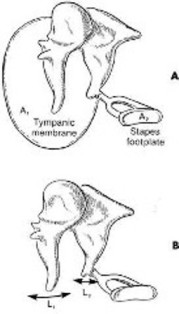

The middle ear consists of the tympanic cavity and the osseous eustachian
tube.
Transmits acoustic energy from the air-filled EAM to fluid-filled cochlea.
Impedance-matching of air to the high impedance of the fluid-filled cochlea.
Impedance-matching 3 ways
Effective vibratory area : most
important
Of TM is17-20x greater than of the stapes footplate.
Lever action of ossicular chain
Arm of the long process of the incus : 1.3x
The length of manubrium and neck of malleus
Shape of TM
Pressure gain : 25-30 dB
Tympanic Membrane
Transfer of power to inner ear
Protection from FB of EAM
Maintaining the air cushion that prevents insufflation of FB from NP
through eustachian tube
Transformer action of TM and ossicular chain provides for a relatively
efficient transfer of power to the inner ear and the fidelity of sound
transmission across the middle ear is outstanding.
Distortion of signal does not occur even >130 dB SPL
Passive mechanical system with both mass and compliant elements and,
therefore, resonant properties
Linear system coupled to the cochlear which contributes a large resistance.
Highly damped and linear and has a wide frequency response
Ratio of volume velocity of the stapes to sound pressure at the TM increases
in humans to about 800-900 Hz – the resonance of middle ear. (50% loss is only 3
dB)
Less than half of the power entering the middle ear reaches the cochlea.
Inefficient at frequencies above 2kHz
The reason humans do not detect and recognize sounds above 20 kHz
The frequency region of greatest energy concentration is 3-5 kHz
2 striated muscles : tensor tympani and stapedium
Protect the cochlea from loud sound
Providing strength the rigidity to the ossicular chain
Reducing “physiologic noise”: Chewing and vocalization
Improving the signal-to-noise ratio for high-frequency signal
Automatic gain control and increasing the dynamic range of the ear
Smoothing out irregularities in the middle-ear transfer function
Protection function of the muscles
Consensual reflex of stapedius
Increases the stiffness of ossicular change and TM
Attenuating sounds below 2 kHz
Stapedial reflex protects the cochlea
Tensor tympani does not normally respond to intense acoustic stimulation
Acoustic reflex latency is greater than 10 msec
Cochlea
A coiled, bony tube about 3.5 mm long.
Divided into the scala vestibuli, scala media and scala tympani
Perilymph : extracellular fluidlike
material
Endolymph : intracellular-like fluid
Scala media has a positive DC RP of about 80 mV,
decreasing slightly from the base to apex : produced by the heavily vascularized
stria vascularis of the lateral wall
“The Battery of cochlea” (Na+/K+-ATPase
pumps).
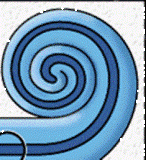

Acoustic energy pathway
Pistonlike action of the stapes footplate in the oval window
Perilymph of the scala vestibuli
Helicotrema
Scala tympani
Organ of Corti : rests on the basilar membrane and osseous spiral lamina
Basilar membrane
0.12mm wide at the base
0.5mm wide at the apex
Organ of Corti
Outer and inner hair cells
Supporting cells : provide structural and metabolic support
Tectorial membrane
Reticular lamina-cuticular plate complex
Outer and inner hair cells of the organ of Corti play a major role in the
transduction of mechanical energy (acoustic) into electrical energy (neural)
The spiral ganglion
Cell body of the auditory n
Sends axons to the cochlear nucleus of the brainstem
Dendrite projects through the osseous spiral lamina
Displacement pattern of the basilar membrane is traveling wave
Stiffer at the base than in the apex
Distributed continuously
Progresses from base to apex
Peak of amplitude of displacement varies as a function of stimulus
frequency
Extremely sharp tuned response
Remarkable frequency-selective abilities
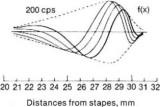
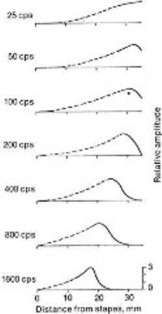
Cochlear amplifier
Active process
Supported by “otoacoustic emission”
Energy of the echo can be grater than the energy of the short-duration
signal
Motility of outer hair cells and mechanical properties of the stereocilia
and tectorial membrane
Stereocilia
Bundles of actin filaments
Inserted into the cuticular plate
Cross-linked between themselves
Of the inner hair cell do not contact to tectorial membrane
Deflection opens and closes nonspecific ion channels at the tips of the
stereocilia, resulting in current flow (K+) into the sensory cell
The potassium flux
Arises from
Endocochlear potential of +80 mV
Negative IC potentials of hair cells (45,70)
Results in IC depolarization
Enzyme cascade involving calcium, ultimately releasing chemical transmitter
Subsequent activation of the afferent n
Neurotransmitter
Aff : Glu
Eff : Ach, GABA
Modify the motility changes of outer hair cell
Hyperpolarization of the cell membrane and a doubling of the cell’s input
conductance
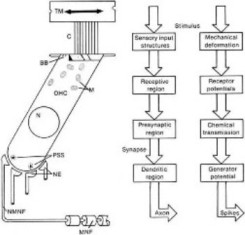
Gross Cochlea Potential
Endolymphatic (endocochlear) potential
DC, 80-10 mV, Scala media
Not generated in response to acoustic stimulation
Cochlear microphonic potential
AC, K+ current flow through outer hair cells
Summating potential
DC, several origin, reflects the DC shifts
Whole nerve action potential
All-or-non discharge of auditory nerve

Gross Cochlear Physiology
Malfunctioning of the mechanism involved in the production of endolymph and
the EP can produce metabolic presbycusis.
When the flow of endolymph is blocked, endolymphatic pressure is increased
and hydrops in produced
Eighth Nerve Physiology
30,000 neurons that innervate the cochlea
Type I neurons : radial fibers
90-95% synapse directly on inner hair cell
Bipolar, myelinated
Each inner hair cell is innervated by about 15-20 type I neurons
Type II neurons : outer spiral fibers
5-10% innervate the outer hair cells
Monopolar, unmyelinated
Each type II neuron branches to afferent innervation pattern of the
cochlea
1,800 efferent fibers originating from SOC
projection to the cochlea
Spontaneous rate
High : 18 to 120 spikes per second
Medium : 0.5 to 18 spikes per second
Low : 0 to 0.5 spikes per second
The most sensitive fibers have the most spontaneous
activity
The most basic measure of auditory nerve function is the tuning curve of a
single fiber.
The tuning curve
Low CF innervate apical region
CF, high and low frequency side, the tail
Normal neural activity, including sensitivity and frequency-resolving power,
depends on intact outer hair cells and
normal stereocilia
One of the most common features of SNHL is
recruitment of loudness.
The tips of the tuning curves are missing and the fibers are not activated
until the level of the signal is sufficient to reach the tails of the tuning
curves.
Abruptly, many fibers then are activated.
Nonlinear Properties of the Ear
The outstanding features of the cochlea and the auditory nerve
Two-tone rate suppression
Otoacoustic emission (OAE)
Spontaneous OAE
Cochlear echo or transiently evoked OAE
Stimulus-frequency OAE
Distortion product OAE
Auditory Central Nervous System


Summarized By Thirayost Nimmanon
â´Â ¸ÕÃÂÊ¶ì ¹ÔÁÁÒ¹¹·ì
 
| 